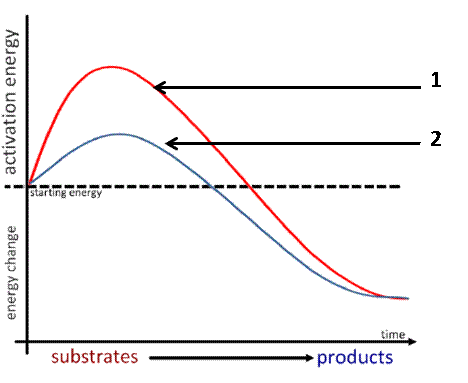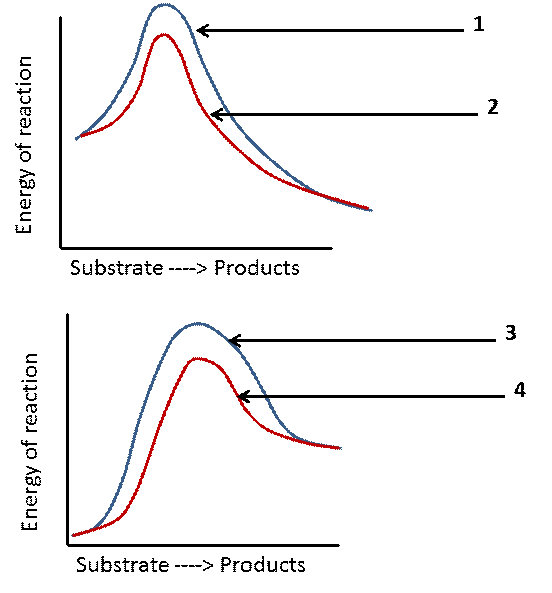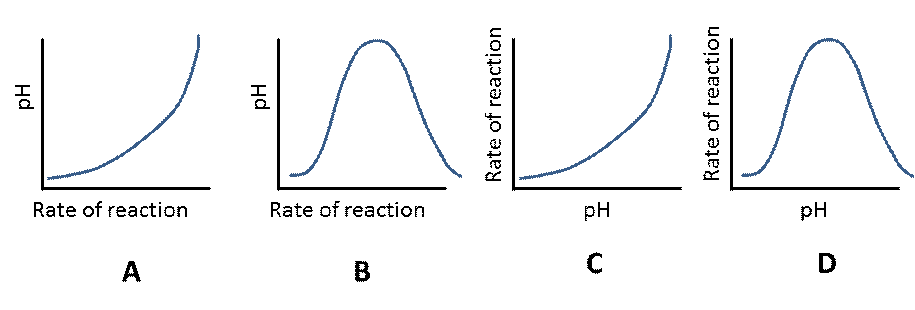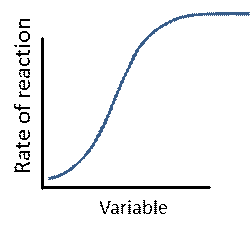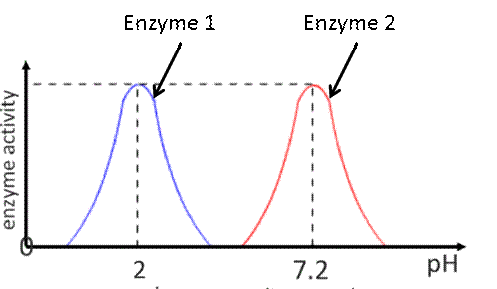Enzymes Online Quiz

Complete this quiz. Due on Monday, 20 November 2011.
- 1.
Which of the following is NOT true about enzymes?
- A.
Enzymes are proteins
- B.
Enzymes lower the activation energy
- C.
Enzymes react with the substrate in a chemical reaction.
- D.
Enzymes catalyzes chemical reactions
Correct Answer
C. Enzymes react with the substrate in a chemical reaction.Explanation
Enzymes are proteins that act as catalysts in chemical reactions, meaning they speed up the rate of the reaction by lowering the activation energy required. They do this by binding to the substrate, the molecule on which the enzyme acts, and facilitating the conversion of the substrate into the product. Therefore, the statement "Enzymes react with the substrate in a chemical reaction" is not true, as enzymes themselves do not undergo any permanent changes during the reaction and are not consumed in the process.Rate this question:
-
- 2.
Study the diagram below. Which of the following is the substrate?
- A.
Hydrogen peroxide
- B.
Water
- C.
Catalase
- D.
Oxygen
Correct Answer
A. Hydrogen peroxideExplanation
The substrate in this diagram is hydrogen peroxide. This is because the diagram shows an enzyme called catalase breaking down hydrogen peroxide into water and oxygen. The substrate is the molecule that the enzyme acts upon, and in this case, it is hydrogen peroxide.Rate this question:
-
- 3.
Which line in the graph shows the presence of an enzyme in a chemical reaction?
- A.
Line 1
- B.
Line 2
Correct Answer
B. Line 2Explanation
Line 2 shows the presence of an enzyme in a chemical reaction because it demonstrates a significant increase in the rate of reaction compared to Line 1. Enzymes are known to catalyze and speed up chemical reactions, and Line 2's steep slope indicates that the reaction is occurring at a faster rate. Conversely, Line 1 shows a slower rate of reaction, suggesting the absence of an enzyme.Rate this question:
-
- 4.
Which line points to an exergonic chemical reaction in the presence of an enzyme?
- A.
Line 1
- B.
Line 2
- C.
Line 3
- D.
Line 4
Correct Answer
B. Line 2 -
- 5.
Which 2 statements are correct about enzyme inhibitors?
- A.
Competitive inhibitors bind to the active site of an enzyme.
- B.
Noncompetitive inhibitors bind to the active site of an enzyme.
- C.
Competitive inhibitors bind to the allosteric site of an enzyme.
- D.
Noncompetitive inhibitors bind to the allosteric site of an enzyme
Correct Answer(s)
A. Competitive inhibitors bind to the active site of an enzyme.
D. Noncompetitive inhibitors bind to the allosteric site of an enzymeExplanation
Competitive inhibitors bind to the active site of an enzyme, which means they directly compete with the substrate for binding to the enzyme's active site. This binding prevents the substrate from binding and inhibits the enzyme's activity. On the other hand, noncompetitive inhibitors bind to the allosteric site of an enzyme, which is a different site from the active site. This binding causes a conformational change in the enzyme, leading to a decrease in its activity. Therefore, the correct statements are that competitive inhibitors bind to the active site of an enzyme, while noncompetitive inhibitors bind to the allosteric site of an enzyme.Rate this question:
-
- 6.
_____________________ energy is the energy required for a chemical reaction to take place.
Correct Answer(s)
activationExplanation
Activation energy is the minimum amount of energy required for a chemical reaction to occur. It is the energy needed to break the bonds of reactant molecules and initiate the formation of new bonds in the product molecules. Without this energy barrier, the reaction would not proceed. Activation energy allows molecules to overcome their energy barriers and reach the transition state, where the reaction can occur. Therefore, activation energy is essential for the initiation of a chemical reaction.Rate this question:
- 7.
_________________ is the region of an enzyme where a substrate binds in a chemical reaction.
Correct Answer(s)
active siteExplanation
The active site is the region of an enzyme where a substrate binds in a chemical reaction. This is where the enzyme and substrate interact, allowing the enzyme to catalyze the reaction and convert the substrate into a product. The active site typically has a specific shape and chemical properties that complement the substrate, allowing for a precise and efficient reaction to occur.Rate this question:
- 8.
__________________ are the reactants in a chemical reaction.
Correct Answer(s)
substrates
substrateExplanation
In a chemical reaction, the substances that undergo a change are called reactants. These reactants are the substances that are present at the beginning of the reaction and are transformed into different products. In this case, both "substrates" and "substrate" refer to the reactants in a chemical reaction. Therefore, both options are correct.Rate this question:
- 9.
_____________________ inhibitors change the shape of an enzyme.
Correct Answer(s)
Noncompetitive
non-competitiveExplanation
Noncompetitive inhibitors, also known as non-competitive inhibitors, are substances that bind to an enzyme at a location other than the active site. This binding causes a change in the enzyme's shape, which ultimately inhibits its activity. Unlike competitive inhibitors, noncompetitive inhibitors do not compete with the substrate for binding to the active site. Instead, they bind to a different site on the enzyme and alter its shape, making it less effective in catalyzing reactions. Therefore, the correct answer is noncompetitive or non-competitive.Rate this question:
- 10.
The ___________________________ model of enzyme action describes how an enzyme slightly changes its shape in order for a substrate to fit in better.
Correct Answer(s)
induced fitExplanation
The induced fit model of enzyme action explains that enzymes can slightly change their shape in response to the binding of a substrate. This change in shape allows the enzyme to better accommodate and interact with the substrate, enhancing the efficiency of the catalytic reaction. In this model, the enzyme and substrate undergo conformational changes upon binding, leading to a tighter fit and optimal positioning of the active site residues for catalysis. This induced fit mechanism ensures specificity and effectiveness in enzyme-substrate interactions.Rate this question:
- 11.
When an enzyme changes shape and becomes non-functional due to factors like extreme pH and temperature, the enzyme is said to be _____________________.
Correct Answer(s)
denaturedExplanation
When an enzyme undergoes denaturation, it means that it has lost its normal shape and structure, rendering it non-functional. This can occur due to various factors such as extreme pH levels or high temperatures. Denaturation disrupts the enzyme's active site, preventing it from effectively binding to its substrate and catalyzing the intended reaction. Consequently, the enzyme loses its biological activity and is considered denatured.Rate this question:
- 12.
Which graph shows the effect of temperature on enzyme activity?
- A.
A
- B.
B
- C.
C
- D.
D
Correct Answer
D. DExplanation
Graph D shows the effect of temperature on enzyme activity because it shows a bell-shaped curve, indicating that there is an optimal temperature at which the enzyme activity is highest. At temperatures below and above this optimal temperature, the enzyme activity decreases. This graph represents the typical response of enzymes to temperature changes, where low temperatures limit the rate of enzyme activity due to slow molecular movement, while high temperatures denature the enzyme and reduce its activity.Rate this question:
-
- 13.
Which graph shows the effect of pH on enzyme activity?
- A.
A
- B.
B
- C.
C
- D.
D
Correct Answer
D. D -
- 14.
Study the graph below. The graph shows the effect of what factor in enzyme activity?
- A.
Temperature
- B.
PH
- C.
Activation energy
- D.
Substrate concentration
Correct Answer
D. Substrate concentrationExplanation
The graph shows the effect of substrate concentration on enzyme activity. As substrate concentration increases, the rate of enzyme activity also increases until it reaches a maximum point, known as the saturation point. At this point, all enzyme active sites are occupied by substrate molecules, and further increase in substrate concentration does not increase the rate of enzyme activity. This graph demonstrates the importance of substrate concentration in regulating enzyme activity.Rate this question:
-
- 15.
The diagram below shows a generalized flow in feedback inhibition. The letters represent substrates or products in the series of metabolic pathway, while the numbers represent the enzymes involved. In this example, how will feedback inhibition take place?
- A.
4 will bind to A to stop the metabolic pathway.
- B.
E will bind to 1 to stop the metabolic pathway.
- C.
E will bind to A to stop the metabolic pathway.
- D.
4 will bind to 1 to stop the metabolic pathway.
Correct Answer
B. E will bind to 1 to stop the metabolic pathway.Explanation
In this example, feedback inhibition will take place when E binds to 1 to stop the metabolic pathway. This is because E is the inhibitor and 1 is the enzyme involved in the pathway. When E binds to 1, it prevents the enzyme from carrying out its catalytic function, effectively stopping the metabolic pathway.Rate this question:
-
- 16.
The highest temperature at which an enzyme maximizes its activity is called the ________________ temperature.
Correct Answer
optimumExplanation
The highest temperature at which an enzyme maximizes its activity is called the optimum temperature. This temperature allows the enzyme to function at its highest efficiency, promoting optimal enzymatic activity. At temperatures below the optimum, the enzyme's activity may be limited, while at temperatures above the optimum, the enzyme may denature and lose its activity. Therefore, the optimum temperature is crucial for achieving the highest level of enzyme activity.Rate this question:
- 17.
Enzyme activity stabilizes even when the concentration of substrate is increased. This is because most of the _________________ are occupied and cannot accomodate more chemical reactions.
Correct Answer
enzymes
enzymeExplanation
Enzyme activity stabilizes even when the concentration of substrate is increased because most of the enzymes are occupied and cannot accommodate more chemical reactions. Enzymes are proteins that act as catalysts in biochemical reactions, and they have active sites where substrates bind and undergo a reaction. When the concentration of substrate increases, more substrates bind to the available active sites on enzymes, leading to an increase in enzyme activity. However, there is a limit to the number of active sites available, and once they are occupied, the enzyme activity stabilizes as additional substrates cannot bind and undergo a reaction. Therefore, the correct answer is enzymes.Rate this question:
- 18.
Excess final products in a series of chemical reaction causes _________________ inhibition.
Correct Answer
feedbackExplanation
Excess final products in a series of chemical reactions can lead to feedback inhibition. Feedback inhibition is a regulatory mechanism where the end product of a metabolic pathway inhibits an earlier step in the pathway. This helps to maintain homeostasis and prevent the overproduction of certain substances. In this case, the excess final products act as feedback molecules that inhibit the enzymes involved in the earlier steps of the reaction, reducing the production of more products. This negative feedback loop helps to control the rate of the reaction and maintain a balance in the system.Rate this question:
- 19.
In feedback inhibition, the first final product will bind to the allosteric site of the ______________ enzyme in a series of chemical reactions.
Correct Answer
firstExplanation
In feedback inhibition, the first final product will bind to the allosteric site of the first enzyme in a series of chemical reactions. This binding will cause a conformational change in the enzyme, leading to its inhibition. This mechanism helps regulate the production of the final product, ensuring that it is produced in the appropriate amounts and preventing excessive accumulation.Rate this question:
- 20.
___________________ are proteins which catalyzes chemical reactions by lowering the activation energy.
Correct Answer
enzymes
enzymeExplanation
Enzymes are proteins that act as catalysts in chemical reactions by reducing the activation energy required for the reaction to occur. They do this by binding to the reactant molecules and facilitating the formation of new bonds or the breaking of existing bonds. Enzymes are highly specific and can only catalyze specific reactions. The presence of enzymes allows reactions to occur at a much faster rate, making them essential for various biological processes in living organisms.Rate this question:
- 21.
__________________ reactions are chemical reactions that build or synthesize products by combining the substrates.
Correct Answer
endergonicExplanation
Endergonic reactions are chemical reactions that require an input of energy in order to proceed. In these reactions, the products are synthesized or built by combining the substrates. This is in contrast to exergonic reactions, where energy is released during the reaction. Endergonic reactions are essential for processes such as photosynthesis and the synthesis of complex molecules in living organisms.Rate this question:
- 22.
____________________ reactions are chemical reactions that break a substrate into smaller components.
Correct Answer
exergonicExplanation
Exergonic reactions are chemical reactions that release energy by breaking down a substrate into smaller components. These reactions are spontaneous and do not require an input of energy. In exergonic reactions, the products have lower energy than the reactants, and the excess energy is released as heat or used to perform work. This process is commonly seen in cellular respiration, where glucose is broken down into carbon dioxide and water, releasing energy in the form of ATP.Rate this question:
- 23.
Energy is ________________ in the products in exergonic chemical reactions.
Correct Answer
releasedExplanation
In exergonic chemical reactions, energy is released in the products. This means that the reaction releases more energy than it consumes, resulting in a net release of energy. Exergonic reactions are typically spontaneous and do not require an input of energy to occur. The released energy can be in the form of heat, light, or other forms of energy.Rate this question:
- 24.
Energy is _______________ by the products in endergonic chemical reactions.
Correct Answer
absorbed
storedExplanation
In endergonic chemical reactions, energy is absorbed and stored by the products. This means that these reactions require an input of energy in order to proceed, and the energy is then stored within the resulting products.Rate this question:
- 25.
Which of the following is NOT an enzyme?
- A.
Amylase
- B.
Sucrose
- C.
Catalase
- D.
Pepsin
Correct Answer
B. SucroseExplanation
Sucrose is not an enzyme because it is a disaccharide composed of glucose and fructose, and it does not catalyze any chemical reactions. Amylase, catalase, and pepsin are all enzymes that catalyze specific reactions in the body. Amylase breaks down starch into sugars, catalase breaks down hydrogen peroxide into water and oxygen, and pepsin breaks down proteins into smaller peptides.Rate this question:
-
- 26.
The graph below shows the optimum activity for 2 digestive enzymes. Which of the following statements is most likely correct about the enzymes?
- A.
Enzyme 1 is most likely to be found in the stomach.
- B.
Enzyme 1 works best at pH 7.
- C.
Enzyme 2 is most likely to be found in the stomach
- D.
Enzyme 2 works best at pH 2.
Correct Answer
A. Enzyme 1 is most likely to be found in the stomach.Explanation
Based on the graph, Enzyme 1 shows the highest activity at a pH of 2, which is consistent with the acidic environment of the stomach. Enzyme 2, on the other hand, shows the highest activity at a pH of 7, which is closer to neutral and suggests that it is more likely to be found in a different part of the digestive system. Therefore, the statement "Enzyme 1 is most likely to be found in the stomach" is the most likely correct statement.Rate this question:
-
- 27.
People with milk digestion problems most likely have difficulties producing which enzyme?
Correct Answer
lactaseExplanation
People with milk digestion problems most likely have difficulties producing lactase. Lactase is the enzyme responsible for breaking down lactose, the sugar found in milk. When lactase is not produced in sufficient amounts, lactose cannot be properly digested, leading to symptoms such as bloating, gas, and diarrhea. This condition is known as lactose intolerance.Rate this question:
- 28.
Cellulose is a tough component of plant fiber. Animals such as cows, horses and goats are able to digest cellulose because of their enzyme called _____________________.
Correct Answer
cellulaseExplanation
Cellulose is a tough component of plant fiber that is difficult for most animals to digest. However, animals such as cows, horses, and goats are able to break down cellulose because they produce an enzyme called cellulase. Cellulase helps to break down the cellulose into smaller, more digestible molecules, allowing these animals to extract nutrients from plant material.Rate this question:
- 29.
Which model of enzyme activity describes a perfect fit between the substrate and the active site of an enzyme?
Correct Answer
lock and key
lock and key modelExplanation
The lock and key model describes a perfect fit between the substrate and the active site of an enzyme. In this model, the active site of the enzyme is like a lock, and the substrate is like a key that fits perfectly into the lock. The active site has a specific shape and chemical properties that allow it to bind with the substrate, forming an enzyme-substrate complex. This model suggests that the enzyme and substrate are rigid structures that do not change shape during the reaction.Rate this question:
- 30.
Which enzyme catalyzes chemical reactions that breaks down a carbohydrate into glucose and galactose?
- A.
Sucrase
- B.
Sucrose
- C.
Maltose
- D.
Maltase
- E.
Lactose
- F.
Lactase
Correct Answer
D. MaltaseExplanation
Maltase is an enzyme responsible for catalyzing the hydrolysis of maltose, a disaccharide, into its constituent monosaccharides, glucose and galactose. It plays a crucial role in carbohydrate metabolism, specifically in breaking down complex sugars into simpler forms that can be readily absorbed and utilized by the body.Rate this question:
-
Quiz Review Timeline +
Our quizzes are rigorously reviewed, monitored and continuously updated by our expert board to maintain accuracy, relevance, and timeliness.
-
Current Version
-
Mar 20, 2024Quiz Edited by
ProProfs Editorial Team -
Nov 17, 2011Quiz Created by
Dropoffpoints
- Anatomy Quizzes
- Bacteria Quizzes
- Bio Quizzes
- Biological Evolution Quizzes
- Biology Exam Quizzes
- Biology Test Quizzes
- Cell Quizzes
- Cell Biology Quizzes
- Chapters Of Biology Quizzes
- Classical Conditioning Quizzes
- Conservation Biology Quizzes
- Fungi Quizzes
- General Biology Quizzes
- Genetics Quizzes
- Immunology Quizzes
- Macromolecule Quizzes
- Marine Biology Quizzes
- Microbiology Quizzes
- Mitosis And Meiosis Quizzes
- Molecular Biology Quizzes
- Parasitology Quizzes
- Physiology Quizzes
- Prokaryote Quizzes
- Protist And Fungi Quizzes
- Protozoa Quizzes
- Respiratory Quizzes
- Spine Quizzes
- Stem Cell Quizzes
- Taxonomy Quizzes
- Traits Quizzes
- Ultimate Biology Quizzes
- Virus Quizzes
 Back to top
Back to top




